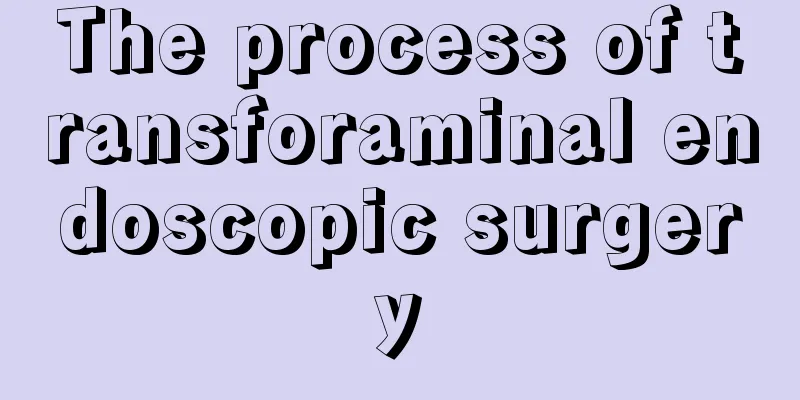The process of transforaminal endoscopic surgery

|
As we all know, perforaminal endoscopic lumbar disc surgery is safe, minimally invasive, less painful, and has good effects. Even though perforaminal endoscopic lumbar disc surgery has many advantages, the process of perforaminal endoscopic lumbar disc surgery must not be taken lightly. What are the common problems in perforaminal endoscopic lumbar disc surgery and the prevention and treatment of complications in perforaminal endoscopic lumbar disc surgery? Let’s take a look at the process of transforaminal endoscopic lumbar disc surgery. Microscopic bleeding is a common occurrence, often resulting in heavy bleeding and unclear vision, which may cause secondary damage or affect the progress of nucleus pulposus removal. Common causes of bleeding include: (1) Coagulation disorder: Therefore, a detailed examination of bleeding, coagulation time and platelet function should be performed before surgery. (2) Intraspinal vein rupture: When entering the spinal canal to explore the nerve roots and intervertebral discs, the swollen venous plexus often bleeds, which is sometimes difficult to stop. Prevention methods: ① Before the operation, the patient should be positioned properly so as not to compress the intra-abdominal veins. ② Observe carefully during the operation and be gentle when examining the nerve roots. ③ For the thicker veins around the nerve roots, damage should be avoided as much as possible. In this case, they must be exposed very carefully to reduce unnecessary impact of various operating instruments. ④ For larger intraspinal veins that cannot be avoided, bipolar electrocoagulation can be used to burn both ends of the blood vessels before treatment. Prevention and treatment strategies for different situations during transforaminal endoscopic lumbar discectomy: (1) The surgeon should fully understand the anatomical characteristics of the spine and the direction and variation of the nerve roots before surgery. Being familiar with the anatomical structure and orientation under the microscope can prevent unclear direction during surgery and help with some special situations, such as the treatment of nerve root departure points and course variations. (2) Be sure to follow the correct standard procedures for discectomy. When expanding soft tissue, the positioning needle should be removed after inserting the second expander to prevent the guide needle from directly damaging the dura mater sac and cauda equina. When expanding and installing the working channel, it should be done under the fluoroscopy of a C-arm X-ray machine to avoid entering the spinal canal. The working tube should be fixed firmly, especially for patients with larger intervertebral lamina spaces. (3) Ensure a clear field of vision. The surgeon must fully master the correct operation of the fiber optic camera system of the percutaneous endoscopic lumbar disc. After entering the spinal canal, the relationship between the nerve root and the protruding intervertebral disc should be clearly observed. Bleeding from the wound outside and inside the channel should be dealt with promptly. Repeated flushing with ice saline during the operation can protect the nerve root and stop bleeding, which is very important for maintaining a clear field of vision. When using bipolar electrocoagulation to stop bleeding, the nerve roots should be protected to avoid nerve root burns. (4) Lateral recess decompression requires extensive experience in traditional surgery and the skills of endoscopic “eye-hand separation” surgery. (5) The dura mater and nerve root stripping should be done gently, especially when there is severe compression or adhesion. You should keep a clear head and proceed step by step. If separation is difficult, do not force it. After reading the rescue measures and countermeasures for various situations during the above perforaminal endoscopic lumbar disc surgery, do you think that there are many other conditions such as bleeding during the perforaminal endoscopic lumbar disc surgery? Do you think that surgery is not an easy thing? This surgery has many advantages and effects. This type of surgery is less painful, so it will be the choice of most patients. |
<<: Treatment of extrapyramidal syndrome
>>: The significance of positive pyramidal tract signs
Recommend
What are the side effects of dust mite drops?
Dust mite drops are a treatment for allergic rhin...
Why do I feel dizzy and my eyes go dark when I wake up?
In real life, many people have experienced dizzin...
What is the best way to treat Helicobacter pylori
First of all, I need to explain to you that Helic...
What to do if your legs are not straight
Many women have high requirements for themselves,...
Chin grinding and plastic surgery
People's faces are very important because the...
How to cool down indoors
In summer, we will feel very stuffy when staying ...
Can honey and flour whiten your skin?
As the saying goes, a white complexion can hide a...
How to effectively treat pseudo-condyloma
Pseudo-condyloma acuminatum, also known as pseudo...
Can advanced ovarian tumors be cured?
Ovarian cancer is one of the common malignant tum...
What should I do if I have hypertrophic pharyngitis
Because the occurrence of hypertrophic pharyngiti...
Is it difficult to get pregnant after teratoma surgery?
Whether teratoma surgery will affect the ability ...
A quick and easy way to treat frostbite
In winter, many people are particularly prone to ...
What are the contraindications for taking mugwort charcoal?
Mugwort is a relatively common Chinese medicinal ...
Clinical manifestations of stomach yin deficiency
Nowadays, many young people have some stomach dis...
Does environmentally friendly paint contain formaldehyde?
As people's awareness of environmental protec...









